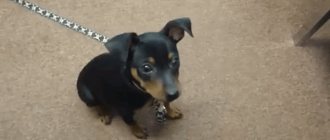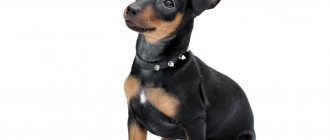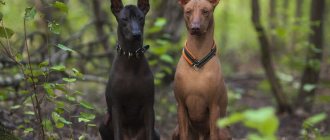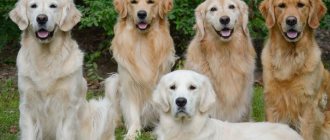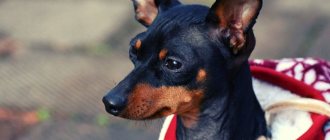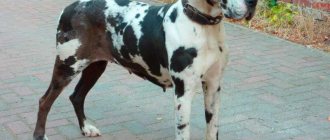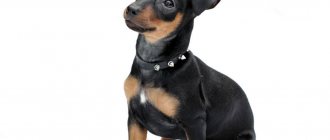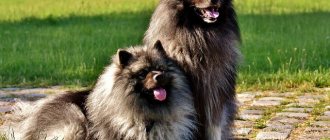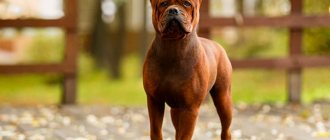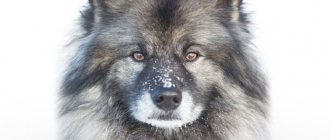Story
The history of the origin of the Doberman began in Germany. The dog was first introduced to the public by Friedrich Doberman at the end of the 19th century. He decided to breed a new variety that would be distinguished by endurance, anger and fearlessness. This required a lot of work. Friedrich crossed some dogs, and his experiment included German Shepherds, Rottweilers and Beaucerons.
As a result, the German achieved the desired result and bred a large Doberman Pinscher. Initially, the breed was called the “Thuringian Pinscher”, however, after the death of Friedrich it was replaced by the “Doberman Pinscher”.
Who is the Doberman Pinscher: man's friend or a killer dog?
The Doberman Pinscher has earned a controversial reputation - many people believe that it is an aggressive and ruthless killer. However, the person who keeps such a pet will definitely say that this is the most wonderful dog in the world. She is loyal, smart, smart and friendly. The secret lies in the owner himself - it depends only on him what kind of animal the animal will become: an aggressive animal or a faithful family friend. In order not to be captured by misconceptions, it is worth considering in more detail the characteristics of this beautiful and graceful breed.
Purpose and application
Dobermans have lightning-fast reactions, sensitivity and fearlessness. Therefore, they are in demand in the following services:
- police;
- VGSCH;
- customs;
- VOKhR.
Pets accompany their owners on hunts, babysit children, and save people. Unlike Europe, in Russia Doberman Pinschers are not widely used as working dogs. They are not adapted to severe frosts and have character traits that are inappropriate for the Russian mentality.
Dobermans love to travel and play sports.
Interesting Facts
The puppies are simply adorable.
The breed is known for several interesting facts:
- He will get along well with a child if he respects the pet’s personal space.
- It is a parallel branch of schnauzers - it differs from them primarily in the type of coat.
- It became widespread in the USSR after the Great Patriotic War - dog lovers brought pinschers as trophies from Germany.
- It is one of the most popular breeds in Europe.
Of course, the German Pinscher is not the easiest pet to keep. But, having got one, every animal lover will simply fall in love with the breed forever and will never regret such an acquisition.
Character and appearance
At first glance, it may seem that Dobermans are unbalanced and angry dogs. However, they are not prone to unreasonable aggression and do not attack people or animals out of the blue. A century ago, breeders carried out several works to soften the character. The result was successful.
The dogs do not have mental problems, so they behave quite gently with their owners. If Dobermans are raised correctly, then such qualities as devotion, observation and attentiveness will certainly appear.
External characteristics of the breed:
- The head is elongated and muscular. When viewed from above or from the side, it will resemble a wedge shape. The forehead is flat, and towards the back of the head the line decreases with a slight rounding. The brow ridges are strongly spread, but do not protrude. There is a smooth expression of the occipital protuberance. The side lines of the head look graceful from above or from the front.
- Nose – the lobe corresponds to the color, wide, well formed with large nostrils.
- Lips are elastic. They fit tightly to the jaws, the mouth is completely closed. The pigmentation matches the color exactly.
- The eyes are most often dark and almond-shaped. In individuals with light coat color they are blue. The edges of the eyelids are drooping.
- The ears are set high, erect and cropped in accordance with the length of the head. In some countries, this procedure is prohibited, so untouched ears are of average size. They fit tightly to the cheekbones with the outer edges.
- Teeth – form a scissor-like taste.
- The neck is muscular, dry, long with a beautiful curve.
- The coat is hard, thick and short, adjacent to the skin, completely distributed over it. There is no undercoat.
- The back is short, but strong. The lumbar region is elastic and convex.
- The chest is moderately wide, resembling an oval shape.
- The front legs are perpendicular to the ground and have prominent muscles.
- The hindquarters are parallel, straight and strong.
The Doberman's tail must be docked properly in the first 2 weeks of his life. In the 20th century, only 4 vertebrae were left with this procedure, however, now the number has dropped to 2-3.
Deviations from the exterior
Miniature Schnauzer: description of the breed, character, features
Each breed has its own appearance, defined by a standard only for it. These are the proportions and strength of the physique, the development of individual parts of the body, endurance and health. Deviation from these standards is considered a defect, such puppies are discarded and are not allowed for breeding.
Deviations from the exterior include:
- non-standard color;
- incorrect body length;
- sagging short back;
- not long enough, crooked, thickened paws;
- incorrect jaw bite;
- long, dull or sparse coat;
- incorrect shape and color of the eyes;
- underdeveloped chest.
Breeding
Doberman breeders have many goals. Some people breed dogs for themselves, while others want to organize a small business in the future. In any case, the breed must be protected and its unique qualities preserved. European countries have developed a whole series of tests that every dog must pass. The main points included in them:
- health check;
- Quality control;
- tests of character.
In European countries, before breeding, the compatibility of male and female dogs is carefully tested. Dobermanns that exhibit abnormal behavior during the test are automatically eliminated. Doberman Pinscher puppies will never become full-fledged dogs if the mother has a bad character. When breeding a breed, the owner is obliged to:
- understand the intricacies of genetics;
- fully know the standard;
- Constantly improve the skills and abilities of dogs.
Description of the breed
The Doberman Pinscher is a reliable, loyal and highly trainable breed. These dogs make excellent companions and guards. In the 19th century they were considered the best police dogs.
Brief description, pros and cons of Dobermans
- Origin: Germany
- IFC classification: Group 2, Section 1
- Height: males - 66-71 cm, females - 61-66 cm
- Weight: males - 40-45 kg, females - 32-32 kg
- Lifespan: 12-15 years
- Cost: from 10 to 60 thousand rubles.
Distinctive features of the breed
- Magnificent watchmen, security guards and detectives.
- They need frequent walks and active games.
- They require mandatory training and development of discipline.
- They have a rather violent temperament.
Advantages
- Devotion.
- They are easy to train.
- They get along with children and can become a good nanny.
- They make fearless bodyguards of the highest class.
- Not fussy to care for.
- They have good health.
Appearance
Dobermans are of average or above average height. They have a strong and muscular build, but these dogs are not without grace, which makes them popular in many countries.
The distinctive external features of Doberman Pinschers are a flat forehead that clearly extends into the muzzle, high-set neck and ears, long withers, a short dorsal part, an oval chest and a tucked belly, forming a beautiful wavy line. Their color always consists of a base color and tan markings on the paws, chest and lower part of the muzzle.
Among Dobermans, there are two species that are so different from each other that they have been proposed to be separated into different breeds: American and European.
American
American-type Dobermans are more elegant and graceful than their European counterparts. They have a long neck with a neat curve, but the line of the head is less smooth. The bones are more fragile than those of Europeans.
The main color of the coat is quite light: light brown or ash. The eyes are lighter than those of Europeans.
European
European Dobermans are the opposite of American ones. Europeans are more massive, with deep chests. They have a straight neck and dark eyes. The color is standard: black or brown at the base and reddish-red tan markings.
Character, temperament, behavioral characteristics
Dobermans are playful and energetic dogs that are very attached to their owners. They love affection and do not tolerate loneliness well. Leaving the animal alone for a long time, you risk getting an embittered, disobedient and unhappy animal.
These dogs are smart and easy to train. They can be turned into both a merciless bodyguard and a loyal friend.
If you establish contact with your pet, love him and show him that you can be trusted, believe me, the Doberman will repay you in full. For this breed, the owner is a king and god with inviolable authority, whom the dog will love for the rest of his dog’s life.
Attitude towards children
Dobermans are excellent tailed nannies. They adore children, do not allow themselves to snap at them and gladly take part in active children's games. Moreover, these dogs perfectly understand the vulnerability of children, so they always try to protect and support them.
Attitude towards people
Males and females have different attitudes towards strangers. If while walking in unfamiliar places both of them simply show wariness, a certain detachment and coldness, then in their own territory their behavior differs.
The bitch is the protector of the family, and this is of paramount importance to her. For her, there are only masters and others, so having an uninvited guest break into her territory is a great way to shorten your life or limbs.
Males, although hot by nature, try not to lose caution at home.
Attitude towards pets
The Doberman's attitude towards animals depends on his childhood and character. If the dog grew up with cats or other small pets, then he will be friendly towards them. Animals can even sleep in an embrace.
Other people's pets will most likely trigger the dog's hunting instinct. As for other dogs in the house, the Doberman prefers to take a dominant position, taking on the role of leader of the pack.
The Doberman Pinscher is a very social animal that is most attached to the family in which it lives.
Education and training
Dogs are very active, so owners often have problems with obedience and development at home. To avoid such difficulties in the future, it is necessary to start training with a Doberman from puppyhood. First of all, you need to establish contact and show who is in charge. As a result, the dog must:
- react calmly to other animals;
- behave neutrally while traveling on all types of transport;
- greet or ignore relatives in a friendly manner;
- do not react to strangers, noise and cars.
The baby must be gradually accustomed to new smells, sounds, and also taken to unfamiliar places. If he is too excited or scared, you can distract him or redirect his attention to something else. The dog should feel comfortable and happy with the owner. He needs to be walked daily for at least 1 hour. It is allowed to let the animal go or play with relatives, but no more than a third of the time of the total walk.
Every owner should teach his pet basic commands from the first days of his life. They need to be secured during household activities, such as feeding, grooming or bathing. Training should be strict, but not cruel. The main commands include:
- "Sit";
- "Stand";
- " To me";
- "Ugh";
- "Place".
Expert opinion
Anna Abramenko
An avid dog lover. Experience in veterinary medicine since 2009.
Ask a Question
You need to train a Doberman in the form of a game. Daily exercises should not exceed 15 minutes. The pet will learn commands only if they are unlearned regularly and gradually. It is recommended to start training at home, since in a familiar environment for the dog it will be easier for him to interact with the owner. Then you can go outside and repeat them in a quiet place.
The general training course begins at six months of age. If this is the first dog in the family, then it is worth hiring a professional. Lack of experience can adversely affect the development and education of the dog. As soon as he turns 1 year old, you can enroll him in protective guard service courses. This will develop in your pet control over aggression and a reaction to danger.
Characteristics, abilities
This is an energetic and gambling dog, distinguished by a lively and cheerful character, and is naturally balanced. A characteristic feature is self-confidence.
The German Pinscher is an intelligent and hardy dog.
Perfect for the role of a guard dog or companion. A devoted and faithful companion.
Suitable for keeping in an apartment. It has the innate traits of a service breed - capable of learning through training and following commands. Aimed at human contact. He is distinguished by his acting abilities and high learning ability. Does not show causeless aggression.
Care and maintenance
The Doberman is quite easy to care for on a daily basis. Even the laziest owners will not have any difficulties. If possible, it is recommended to keep the dog in an enclosure, but only if it is insulated. The animal is not adapted to the cold and can quickly freeze.
The following items must be included in regular procedures:
- Wool. It must be wiped with a towel daily. This will remove the fallen pieces. During shedding, you can use a vacuum cleaner. The main thing is to accustom your pet to the procedure at the initial stages. Otherwise, loud howling sounds may frighten him.
- Claws. After each walk, it is recommended to wipe your paws with a cloth. Trim claws if necessary.
- Teeth. Plaque should be removed daily with cotton swabs, using paste or powder.
- Eyes. Corners must be cleaned of accumulated secretions. To do this, use a piece of bandage.
- Ears. Their shells are wiped with gauze or cotton swabs once every few weeks.
Mating
Doberman matings are not always reproductive, as the breed's population is large. In any case, animals must be vaccinated, free of diseases and comply with the rules.
Puberty begins around 8-9 months of age. At this time, the females begin to estrus, and the males go into cages.
Breeding should begin only 20 months after the start of the third heat. You can determine a girl’s readiness for several reasons:
- The animal spreads its paws and throws its tail;
- The discharge lights up;
- The cycle begins to increase.
To carry out the decoupling without problems, you can invite a specialist. This will help the pets and simplify the mating process. To begin with, a girl is brought to the man, at this stage they get to know each other. The process takes about 15 minutes, during which time the animals sniff and get used to it. As soon as the bitch is ready, she will allow the boy to sit.
Sexual intercourse lasts about 10 minutes, the block is longer - from 15 to 30 minutes. The female should rest on her stomach and should not sit down. The cables must run in a ring. If there is a sharp difference in size, the male may not get it, in such cases it should be planted. Knitting must be repeated after 2 days.
Nutrition
The diet directly depends on the choice of feeding option. Most often, Dobermans are given a dry or natural product. They differ in characteristics that need to be taken into account when eating. Based on the type and price, vitamins and minerals are present in dry and liquid food.
Natural ingredients suitable for Doberman:
- porridge in broth. For example, rice, buckwheat or millet;
- fresh vegetables;
- raw meat (but not pork);
- fermented milk products.
Sometimes meat can be replaced with boiled fish, previously cleaned of bones, or an egg can be added to the dish once a week. It is not recommended to change your diet suddenly. Problems with the digestive system may arise, causing the food to not be absorbed normally. Products should be introduced into the diet gradually over two weeks.
Diseases
The Doberman rarely gets sick. Although the dog is large and hardy, it has a number of diseases:
- Joint dysplasia
- Cataract
- Partial baldness
- Melanoma
- Genetic von Willebrand disease causing internal bleeding
- Volvulus of the stomach and intestines
- Dental problems - malocclusion and loss of incisors
- Older dogs may experience heart and musculoskeletal problems.
- The breed is prone to obesity and to prevent this disease it is necessary to observe the norm and frequency of food intake.
Health and treatment
Dobermans have strong immunity, however, they are often susceptible to various ailments, which are most often inherited. The main ones include:
- eye inflammation;
- bloating;
- liver damage;
- chronic hepatitis;
- lipoma;
- dysplasia of the hip and elbow joints;
- spinal cord diseases;
- thyroid problems;
- congenital deafness;
- hair loss;
- weak heart function.
Before buying a Doberman Pinscher, you need to carefully study its pedigree, since ailments are often transmitted genetically from a male or female dog. You also need to request various medical certificates and documentation from the breeder. This will allow you to avoid purchasing a sick pet, which in the future can produce bad offspring. If suspicious symptoms occur, you should promptly contact a veterinarian.
Table: possible diseases and preventive measures
| Diseases | Treatment | Prevention |
| Dysplasia (destruction) of the hip joint. | Warming the joints with paraffin or ozokerite. Application of laser and electromagnetic radiation. Surgical intervention. | Preventing obesity in dogs, providing the necessary physical activity. |
| Arthritis is inflammation of the joints. | Use of the drug Rimodil, Metacam. | Balanced quality nutrition. |
| Cataract is clouding of the lens of the eye, resulting in weakened vision. | Surgical intervention, replacing the old lens with an acrylic or plastic lens. | Proper nutrition, prevention of the development of diabetes, as well as mechanical, thermal and chemical injuries to the eye. |
| Von Willebrand-Jurgens syndrome is a blood disorder that reduces clotting. | The disease is incurable. | Dogs with this syndrome should not be used for breeding. |
Lifespan
The lifespan of an individual directly depends on the following factors:
- Maintenance and care. The animal must live in a warm place, be active, and receive physical activity.
- Heredity. Diseases that are transmitted genetically can significantly shorten life.
- Nutrition. Poor quality food has a negative impact on the pet’s digestive system, which can result in disruption of the functioning of the entire body.
If you follow all the rules and pay attention to the dog, then on average he will live 12-15 years.
How to choose the right Doberman Pinscher puppy?
Before buying, you should learn everything about Dobermans to understand whether this breed is suitable for a particular person. It is advisable to consult with other owners, visit special breed exhibitions, and personally communicate with the animals.
Important. The characteristics of the Doberman Pinscher depend more on upbringing than on the innate qualities of the puppy.
Pedigree Doberman puppies purchased from a trusted nursery are distinguished by good health and balanced temperament. Therefore, there is no need to take risks and buy a baby from your own hands. Unscrupulous sellers often breed sick dogs or animals with mental disabilities.
A responsible breeder always keeps Doberman puppies in a clean enclosure. People who try to sell babies too early deserve no attention. Pets must be under the supervision of their mother for up to 2 months. If a breeder wants to sell dogs that are barely 4-5 weeks old, it is better to choose another kennel.
Healthy Doberman puppies are active, playful and curious. They have a shiny and smooth coat, clean eyes and ears, and an attentive and lively look. Dogs show sincere interest in everything that happens and are not afraid of strangers.
You should talk to the breeder:
- find out in what conditions Doberman puppies grew up;
- how old are their parents;
- Do dogs have hereditary diseases?
Don't be shy about asking for documents.
To choose the right Doberman puppy, it is advisable to examine several litters and compare different babies. Dog handlers do not recommend purchasing dogs if half of them have already been sold - the best pets are usually taken first. Purebred Doberman puppies can be purchased in Moscow in the kennels GretchenDorf, Iz Zoosfery, OttoGeller.
Important. Doberman puppies must have birth certificates and a veterinary passport.
Advantages and disadvantages
| pros | Minuses |
| Learn quickly | Manifestation of aggression while defending territory or owner |
| Friendly | Howling when the dog is alone |
| Get along with children | Wayward character |
| Look attractive | Dislike of relatives |
| Developed intelligence | |
| Loyal to their owners |
List of suitable nicknames
Owners must choose the right option based on external data and character traits.
| For girls | For boys |
| To highlight your appearance | |
| Sicily, Grace, Liana, Jessie, Selena, Prima, Kara | Titan, Karl, Iron, David, Zeus, Veles, Conan, Hector, Stark, Gucci |
| For a violent character | |
| Adele, Hera, Alice, Camilla, Rochelle, Tsara, Utah, Helga | Hunter, Onyx, Oscar, Baron, Herman, Polkan, Dante, Prime |
| For the brave | |
| Gel, Krista, Demi, Mist, Mulan, Rexy, Ulma, Gerda | Hagen, Achi, Raivel, Atli, Holger, Gunnar, Grom, Nord, Duncan |
Rules for choosing puppies
First of all, you need to pay attention to the following nuances:
- Breeder accreditation. This approach reduces the risk of acquiring a sick baby. In this case, you can give the pet back based on the contract.
- Examination of the puppy's parents. From here it will be possible to determine the character and temperament of adult individuals, as well as assess their state of health.
- Do not buy puppies through online sites.
If you decide to get a Doberman for the first time, then it is best to take a girl. They are faster to train and obedient. Males love to show character and disobey their owner.
miniature pinscher
Translated from German, miniature pinscher is a dwarf pinscher (the most common name in Russia). Also called the Miniature Pinscher (Mostly in the USA).
True Miniature Pinschers are proud, determined, muscular, beautiful and full of energy. Ideally, the Miniature Pinscher is this small copy of the Doberman Pinscher. Or more precisely, a smaller copy of the German Pinscher (45-50 cm tall), similar to the Doberman Pinscher. This miniature and nimble dog is considered ideal for a city dweller who dreams of a sporty, cheerful companion. After all, the pinscher has a lot of advantages: he is a unique watchman, he always senses danger before other, taller dogs and is the first to warn his owners about it. The pinscher gets along well with animals living in the house, but always tries to take the place of leader, even if the neighbor, for example, is a bull terrier. In addition, the Pinscher is very attentive and obedient, he is very trainable and loves games. Despite its small size, this is a very hardy dog with enviable health. Like any guard dog, the Pinscher is immensely loyal to its owners, and is wary of strangers. The fearlessness of the little pinscher is difficult to describe; he is never afraid of anything, and is ready to fight for his beloved owners to the last drop of blood. By the way, it is precisely thanks to its courage, dexterity, and quick reactions that the miniature pinscher sometimes manages to give a worthy rebuff to a much stronger opponent.
His short coat requires minimal grooming. It is ideal for apartment living and only needs a small space for physical activity. However, it does not tolerate cold and should never be kept outside. But he will always be happy for walks in any weather. For those who like to travel, the miniature pinscher is also an ideal companion: it is compact, tireless, and most importantly, devoted to its owner, whom it is ready to follow to the ends of the earth.
The miniature pinscher's loving nature, obedience and intelligence have won him the love of people of all ages. And his courage, energy and passion for attracting attention leave him with few competitors among other breeds. Always cheerful, extremely attentive and easy to train, this Pinscher often outperforms its larger counterparts in competitions.
The Miniature Pinscher is called the “King of Miniature Dogs.” And it must be said that he was “awarded” such a high title quite deservedly, because the purebred representative of the breed is distinguished by his extraordinary beauty, sharp mind, rare intuition and truly royal elegance. The short, smooth and shiny coat emphasizes the strict, noble silhouette of this dog.
The Pinschers' coat is very short and cannot hide any occasional defect in build. This also makes them look a little slimmer than their Schnauzer cousins. At your leisure, you can admire their impeccable silhouette and, in particular, their muscles. For all their elegance, they must still remain strong dogs so as not to look too light and skinny, like Italian greyhounds. The angles of the limbs are well defined, the head is wedge-shaped, the skull is the same length as the distance from the eyes to the tip of the nose. But the length of the muzzle should not be too long - a Pinscher with the head of a Manchester Terrier would not meet the breed standards.
It is important to know that the build of the Miniature Pinscher should not at all emphasize the shortcomings that are rightly associated with the miniaturization of the breed - such as an apple-shaped head, spherical eyes, puny legs or sparse hair. Such dogs, which can sometimes be found on the street, have only a vague resemblance to a pinscher.
The term "miniature" would probably be preferable to describe this little dog - so athletic, so well built, that it surprises and inspires tender feelings when it claims the title of Best in Group in the show among the huge dogs of the second group. His behavior is also unique: he holds his head proudly straight, he moves, throwing his front paws forward, like a real little horse.
The pinschers' tail and ears were cropped. Tail docking is done in the first five to seven days of life, leaving 2-3 vertebrae. The ears are shaped into “candles” or sharp triangles by cutting off the earlobe, this is done by 3-4 months. Due to the ban on docking in many European countries, it is now more common to see Pinschers with naturally hanging ears, which visually increases the thickness of the neck. In this case, the ears are shaped into a "V" shape with the top tip drooping and move toward the front of the skull when the dog becomes alert. But this detail should be noted as particularly important in its field: some lines of Pinschers have ears that are naturally erect, which is genetic in them, and it seems that this is not a recent acquisition, but has been characteristic of this breed since very ancient times. Sometimes it happens to crop the ears of a puppy whose ears would have straightened later on their own. But complete correspondence is difficult to achieve for this type of ears, which are either too floppy or look too large, which threatens the miniature pinscher with an inappropriate resemblance to a toy terrier.
The natural tail of a miniature pinscher should be straight, without creases, saber-shaped or sickle-shaped, but more twisted options are also possible, which today are not yet fined at exhibitions - breeders are given time to select by selection the type of tail desired by the standard and at the same time not lose other valuable qualities exterior.
Materials - https://www.multatuli.ru/index.php/ru/opisanie.html
Puppy cost
It is advisable to look for a Doberman only from trusted breeders. It is recommended to read the information about the seller in advance, find out the address and cost. In many countries, a pet will cost in the range from 12 to 90 thousand rubles. In Russia, different prices are set.
Puppy price:
| Product | price, rub. |
| Mixed Doberman | from 1000 |
| Pet without documents in Moscow | 3000-10000 |
| With relevant papers | 1200-15000 |
| Purebred dog | 20000-60000 |
Where to buy and price
Doberman Pinscher is a very popular breed in Russia, so finding a purebred puppy will not be difficult. Nurseries exist in both large and small cities. It is better to give preference to officially registered ones.
List of nurseries:
- Santa Julf (St. Petersburg);
- Pride of Russia (Moscow);
- Versailles Manific (St. Petersburg);
- Farida Spiranta (Moscow);
- Excalibur (Krasnoyarsk);
- Random Will (Vologda);
- Irhouse (Arkhangelsk).
Average price for puppies: 15,000-55,000 rubles. You can buy it secondhand even for 8,000.
Reviews
Natalya, Surgut: “The dog is complex. It takes a lot of time and effort to raise and train. I believe that the Doberman is not suitable for every person. Only leaving does not cause difficulties.”
Vladimir, Smolensk: “I was looking for a breed for a year, and a friend advised me to pay attention to the Doberman. I read the description of this variety, but had my doubts. I found a trusted breeder, checked the documents and pedigree of the dog. The family has been in the family for 7 years, there are no illnesses. We’re thinking about breeding puppies.”
Lyudmila, Omsk: “My husband and I bought a girl. We were satisfied. They quickly taught him commands, and there were no problems with education either. He gets along well with children and has never been bitten by a dog. They called it Nora."
Photo and video review
Dobermans are beautiful animals. You can clearly see them in photos and videos.
The German Doberman breed can become a true friend for its owners. The dogs are active, peaceful and get along with children. They rarely cause inconvenience to their owners and are easy to care for.
